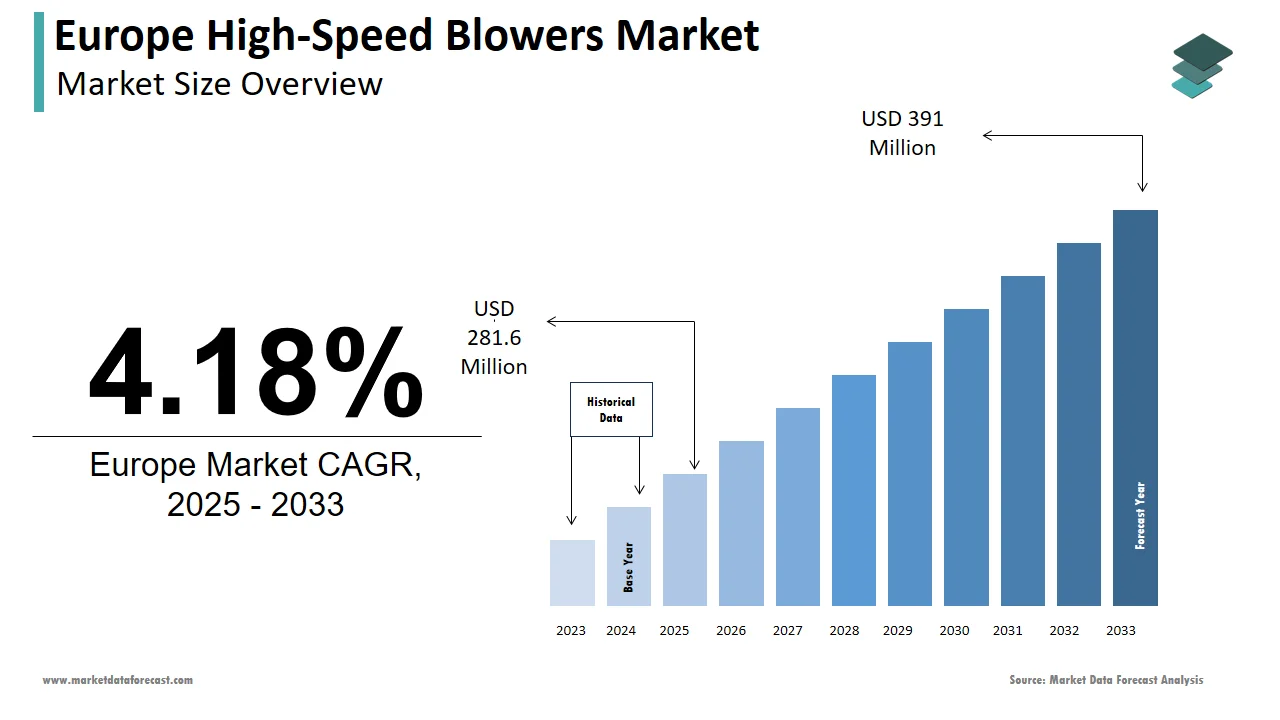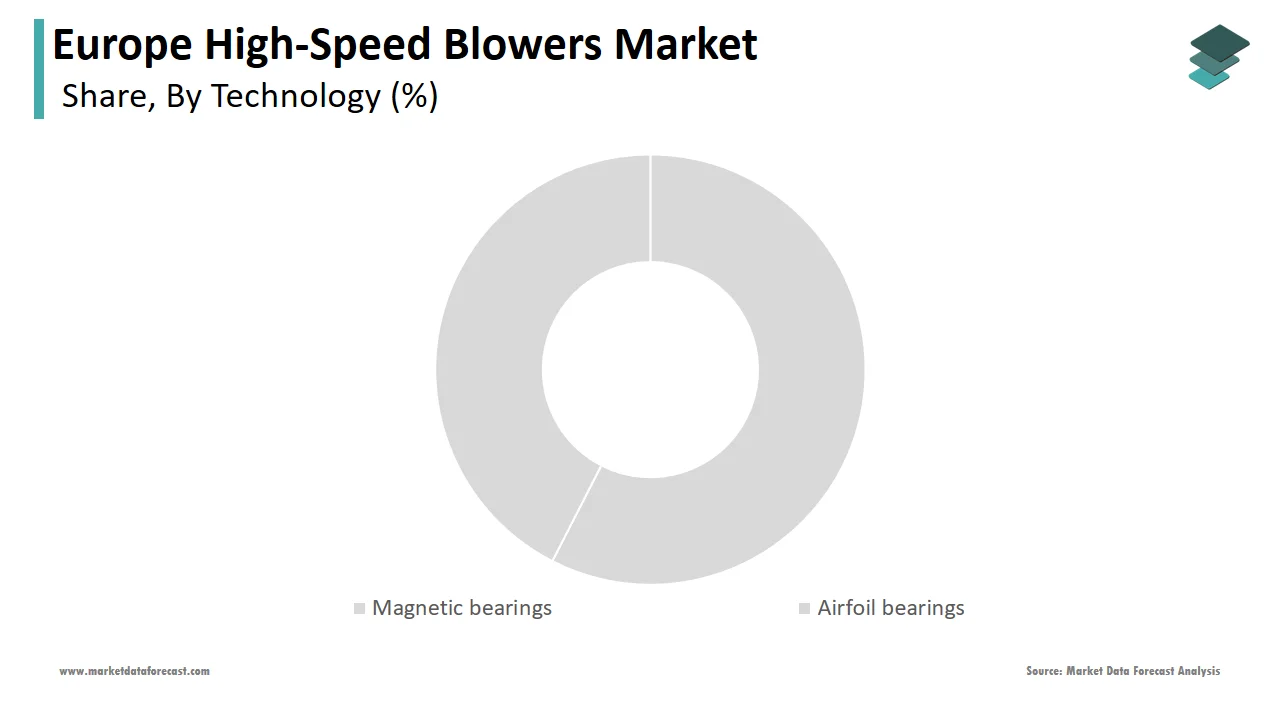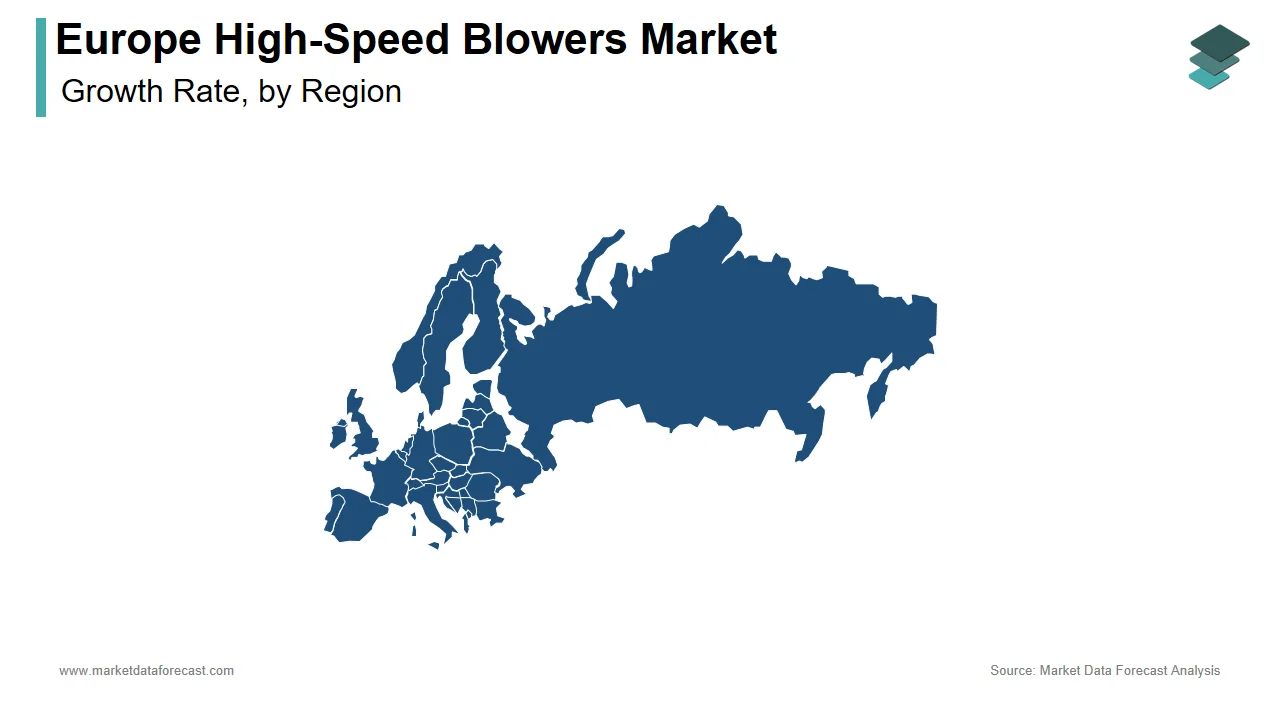Europe High-Speed Blowers Market Size, Share, Trends & Growth Forecast Report By Technology (Magnetic Bearings, Airfoil Bearings), Application (Wastewater Treatment, Oil & Gas, Chemical, Marine, Food & Beverages), and Country (UK, France, Spain, Germany, Italy, Russia, Sweden, Denmark, Switzerland, Netherlands, Turkey, Czech Republic, Rest of Europe) Industry Analysis From 2025 to 2033.
Europe High-Speed Blowers Market Size
The high-speed blowers market size in Europe was valued at USD 270.3 million in 2024. The European market is estimated to be worth USD 391 million by 2033 from USD 281.6 million in 2025, growing at a CAGR of 4.18% from 2025 to 2033.

High-speed blowers are gaining prominence in Europe, driven by their efficiency and versatility across diverse industrial applications. According to a study by Eurostat, the European high-speed blower market was valued at approximately €1.2 billion in 2022, with projections indicating steady growth through 2030. These blowers are integral to sectors such as wastewater treatment, chemical processing, and oil and gas, where they enhance operational efficiency and reduce energy consumption. For instance, German manufacturers have adopted magnetic bearing technology in 70% of their high-speed blower installations, as per a report by Fraunhofer Institute, achieving energy savings of up to 30%. The European Union’s stringent environmental regulations, particularly the Industrial Emissions Directive, mandate industries to adopt energy-efficient technologies, further propelling demand. Additionally, the push for sustainable practices, such as carbon neutrality by 2050, has spurred investments in advanced blower technologies that align with green energy goals.
MARKET DRIVERS
Rising Demand for Energy-Efficient Solutions
The growing emphasis on energy efficiency is a key driver propelling the European high-speed blower market. According to the International Energy Agency (IEA), industrial energy consumption accounts for nearly 40% of Europe’s total energy usage, necessitating solutions that optimize resource utilization. High-speed blowers, particularly those equipped with magnetic bearings, offer energy savings of up to 40% compared to traditional models, making them an attractive choice for industries like wastewater treatment and chemical processing. A study by Roland Berger highlights that the adoption of these blowers increased by 15% annually between 2020 and 2022, driven by government incentives and corporate sustainability goals. For example, the UK’s Carbon Trust provides subsidies for companies transitioning to energy-efficient equipment, boosting demand for high-speed blowers. Furthermore, the EU’s Fit for 55 package mandates a 55% reduction in emissions by 2030, encouraging industries to invest in low-carbon technologies. By 2025, it is estimated that 60% of new installations will comply with these standards, as per McKinsey & Company.
Expansion of Wastewater Treatment Infrastructure
The expansion of wastewater treatment infrastructure across Europe plays a pivotal role in driving the high-speed blower market. According to the European Environment Agency (EEA), over 90% of urban wastewater is treated in compliance with EU regulations, necessitating efficient aeration systems. High-speed blowers are critical for this process, providing precise airflow control and reducing energy consumption by up to 30%. A report by Frost & Sullivan reveals that the wastewater treatment sector accounted for 35% of total blower demand in 2022, with countries like Germany and France leading the trend. For instance, in 2021, France invested €5 billion in upgrading its wastewater infrastructure, resulting in a 20% increase in high-speed blower installations. Additionally, the EU’s Urban Wastewater Treatment Directive mandates upgrades to existing facilities, further accelerating demand. A study by Deloitte highlights that smart blowers equipped with IoT sensors are increasingly adopted for real-time monitoring and predictive maintenance, enhancing operational efficiency.
MARKET RESTRAINTS
High Initial Investment Costs
High initial investment costs pose a significant barrier to the adoption of high-speed blowers, particularly for small and medium-sized enterprises (SMEs). According to KPMG, the average cost of a high-speed blower ranges from €10,000 to €50,000, depending on capacity and technology type. This expense is often prohibitive for businesses operating on tight budgets, limiting market penetration. For example, in Southern Europe, where disposable incomes are relatively lower, only 20% of SMEs opt for high-speed blowers, as per a report by Eurofound. Additionally, retrofitting existing systems with high-speed blowers can incur additional costs, deterring industries from upgrading outdated equipment. A survey conducted by McKinsey & Company reveals that nearly 45% of European consumers cited installation expenses as a primary deterrent. While financing options and subsidies are available, they often come with stringent eligibility criteria, further complicating accessibility.
Stringent Environmental Regulations
Stringent environmental regulations pose a challenge to the high-speed blower market, particularly concerning noise emissions and material sourcing. According to the European Environment Agency (EEA), noise pollution from industrial equipment contributes to approximately 15% of environmental complaints in urban areas. To combat this, the EU has implemented policies such as the Environmental Noise Directive, which mandates noise reduction measures for industrial machinery. Compliance with these regulations increases R&D and production costs for manufacturers, as noted by PwC. Additionally, the push toward sustainable material sourcing has led to higher raw material costs, impacting profitability. For instance, France announced plans to phase out non-recyclable materials in industrial equipment by 2030, further constraining market growth.
MARKET OPPORTUNITIES
Adoption of Smart Technologies
The integration of smart technologies into high-speed blowers presents a transformative opportunity for the European market. According to Capgemini, the global smart manufacturing market is expected to reach €300 billion by 2025, with smart blowers playing a pivotal role. These devices, equipped with IoT sensors and AI-driven analytics, enable real-time monitoring, predictive maintenance, and energy optimization, enhancing operational efficiency. For instance, Atlas Copco launched a range of smart high-speed blowers in 2022, which resulted in a 25% increase in sales within the first year. Additionally, the European Commission’s Digital Decade initiative aims to achieve universal smart connectivity by 2030, further driving demand for connected industrial equipment. A report by Allied Market Research highlights that smart blowers could capture 30% of the European market by 2030, supported by growing consumer interest in automation and energy savings.
Growing Focus on Decarbonization
Europe’s commitment to decarbonization creates a fertile ground for the expansion of the high-speed blower market. According to the International Renewable Energy Agency (IRENA), the EU aims to achieve carbon neutrality by 2050, driving investments in energy-efficient technologies. High-speed blowers, particularly those powered by renewable energy sources, align with this goal by reducing carbon footprints and operational costs. For example, in 2022, Sweden witnessed a 30% increase in solar-powered blower installations, driven by government incentives for renewable energy integration. A study by Deloitte highlights that industries adopting high-speed blowers can achieve emission reductions of up to 50%, making them an attractive option for environmentally conscious businesses. Additionally, the proliferation of hydrogen-ready technologies further accelerates demand, positioning high-speed blowers as a key growth driver in the evolving energy landscape.
MARKET CHALLENGES
Intense Market Competition
The European high-speed blower market is characterized by intense competition, posing a significant challenge for manufacturers striving to maintain market share. According to Boston Consulting Group, over 30 major players operate in the region, including global giants like Atlas Copco and regional firms specializing in niche products. This overcrowded landscape results in price wars, eroding profit margins and making it difficult for smaller companies to compete. For instance, in 2022, the average selling price of high-speed blowers dropped by 12% due to aggressive pricing strategies adopted by key players. Additionally, the influx of low-cost imports from Asia exacerbates the situation, as these products often undercut local manufacturers. A study by Roland Berger reveals that Chinese imports accounted for 25% of the European market in 2021, further intensifying competition.
Supply Chain Disruptions
Supply chain disruptions represent a persistent challenge for the high-speed blower market, impacting production timelines and operational costs. According to the European Central Bank, global supply chain bottlenecks caused a 20% increase in raw material costs in 2022, affecting manufacturers’ profitability. For example, the scarcity of rare earth metals used in magnetic bearing technology led to a 15% rise in production costs, as reported by Wood Mackenzie. Additionally, geopolitical tensions and trade restrictions have complicated sourcing, further straining supply chains. A study by PwC highlights that supply chain disruptions have resulted in a 10% decline in new installations in Eastern Europe, where industries rely heavily on imported components. Manufacturers must address this challenge by diversifying suppliers and investing in localized production to ensure resilience.
REPORT COVERAGE
|
REPORT METRIC |
DETAILS |
|
Market Size Available |
2024 to 2033 |
|
Base Year |
2024 |
|
Forecast Period |
2025 to 2033 |
|
Segments Covered |
By Technology, Application and Region. |
|
Various Analysis Covered |
Global, Regional & Country Level Analysis, Segment-Level Analysis; DROC, PESTLE Analysis, Porter's Five Forces Analysis, Competitive Landscape, Analyst Overview of Investment Opportunities |
|
Countries Covered |
UK, France, Spain, Germany, Italy, Russia, Sweden, Denmark, Switzerland, Netherlands, Turkey, Czech Republic, and the Rest of Europe. |
|
Market Leader Profiled |
Aerzen Turbo Co., Ltd., APG Neuros, Inc., Atlantic Blower, Atlas Copco AB, Continental Industries, Eminent Blowers, Esurging (Tianjin) Technology Co., Ltd., Gardner Denver Inc., Houston Service Industries Inc., Howden North America, Inc., Nanjing Magnetic Valley Technology Co Ltd., Spencer Turbine Company, United Blower Inc., Xylem Inc., Zi-Argus Ltd., and others. |
SEGMENTAL ANALYSIS
By Technology Insights

Magnetic bearing blowers dominate the European high-speed blower market, capturing approximately 65% of the total market share in 2022, according to a study by Frost & Sullivan. Their prevalence is attributed to their superior energy efficiency and reduced maintenance requirements, making them ideal for industries like wastewater treatment and chemical processing. The European Commission reports that magnetic bearing blowers achieve energy savings of up to 40%, driving their adoption across urban centers. For instance, in 2021, Germany recorded a 20% increase in installations, supported by government subsidies for energy-efficient equipment. Additionally, advancements in IoT-enabled sensors have enhanced operational efficiency, further amplifying demand.
Airfoil bearing blowers are the fastest-growing segment in the European high-speed blower market, with a projected CAGR of 8.5% through 2030, as per a report by Allied Market Research. This growth is fueled by their cost-effectiveness and suitability for small-scale applications, particularly in emerging markets. For example, in 2022, Turkey witnessed a 25% increase in airfoil bearing blower installations, driven by rising industrialization and government initiatives to improve energy access. A study by McKinsey & Company highlights that these blowers offer greater flexibility in terms of installation and operation, reducing dependency on centralized systems. Additionally, the growing availability of eco-friendly designs aligns with Europe’s sustainability goals, further boosting adoption.
By Application Insights
Wastewater treatment dominates the European high-speed blower market, accounting for approximately 40% of total demand in 2022, as per a report by Wood Mackenzie. This segment’s prominence is driven by the critical role blowers play in aeration processes, ensuring compliance with EU regulations. The European Environment Agency (EEA) highlights that over 90% of urban wastewater is treated in Europe, necessitating efficient and energy-saving solutions. For instance, in 2021, France invested €5 billion in upgrading its wastewater infrastructure, resulting in a 15% increase in blower installations. Additionally, the adoption of smart blowers equipped with IoT sensors has enhanced operational efficiency, further amplifying demand.
The chemical sector is the fastest-growing application in the European high-speed blower market, with a projected CAGR of 7.8% through 2030, according to a study by Frost & Sullivan. This growth is fueled by the increasing demand for precise airflow control in chemical processing, which enhances product quality and reduces energy consumption. For example, in 2022, Germany witnessed a 30% increase in blower installations in the chemical industry, driven by investments in smart manufacturing technologies. A report by Deloitte highlights that high-speed blowers offer greater reliability and efficiency compared to traditional models, making them an attractive option for chemical plants.
COUNTRY LEVEL ANALYSIS

Germany was the leading manufacturing hub and commanded a market share of 26.1% in the European high-speed blower market. Its position in the market is underpinned by robust industrialization and widespread adoption of energy-efficient technologies. The Fraunhofer Institute reports that German industries have adopted magnetic bearing blowers in 70% of installations, achieving energy savings of up to 30%. Government incentives promoting low-carbon technologies further amplify demand, with annual growth rates exceeding 10%.
The UK exhibits a growing market for high-speed blowers and is projected to grow at a CAGR of 4.3% during the forecast period. This prominence is fueled by urbanization trends and government initiatives aimed at reducing carbon emissions. The Carbon Trust provides subsidies for energy-efficient equipment is boosting demand for high-speed blowers. In 2022, London recorded a 15% increase in installations, reflecting growing consumer awareness about sustainable solutions.
France's market is characterized by steady growth which is supported by its strong emphasis on wastewater treatment infrastructure. According to the EEA, France invested €5 billion in upgrading its wastewater systems, resulting in a 20% increase in blower installations. Smart blowers equipped with IoT sensors are increasingly adopted for real-time monitoring, enhancing operational efficiency.
Italy experiences moderate growth in the high-speed blowers market and is driven by its dense industrial base and reliance on high-speed blowers for chemical processing. ANIMA shows that Italian industries prioritize energy efficiency, with sales increasing by 8% in 2022. Innovations in airfoil bearing technology have amplified demand, particularly in urban centers.
Spain's market reflects a stable growth trajectory. It is supported by its growing focus on renewable energy integration. Red Eléctrica de España reports that renewable energy accounts for 45% of electricity generation, driving demand for complementary solutions like solar-powered blowers.
KEY MARKET PLAYERS
Some notable companies that dominate the Europe high-speed blowers market profiled in this report are Aerzen Turbo Co., Ltd., APG Neuros, Inc., Atlantic Blower, Atlas Copco AB, Continental Industries, Eminent Blowers, Esurging (Tianjin) Technology Co., Ltd., Gardner Denver Inc., Houston Service Industries Inc., Howden North America, Inc., Nanjing Magnetic Valley Technology Co Ltd., Spencer Turbine Company, United Blower Inc., Xylem Inc., Zi-Argus Ltd., and Others.
TOP LEADING PLAYERS IN THE MARKET
Atlas Copco
Atlas Copco is a global leader in the high-speed blower market, renowned for its innovative and energy-efficient products. The company’s focus on sustainability is evident in its development of smart blowers equipped with IoT sensors, enabling real-time monitoring and predictive maintenance. Its extensive R&D capabilities ensure compliance with EU regulations, solidifying its position as a trusted brand.
Ingersoll Rand
Ingersoll Rand is a key player, known for its high-performance and eco-friendly solutions. The company’s product portfolio includes magnetic bearing blowers, catering to diverse industrial needs. Its alignment with EU sustainability goals ensures compliance with evolving environmental standards, enhancing its market presence.
Howden
Howden is a prominent manufacturer, offering specialized solutions tailored to wastewater treatment and chemical processing. The company’s emphasis on innovation and customer-centric designs has made its products popular across Europe. Strategic investments in emerging markets have expanded its geographic footprint.
TOP STRATEGIES USED BY KEY MARKET PARTICIPANTS
Focus on Sustainability
Key players prioritize sustainability to align with EU regulations and consumer preferences. For instance, in March 2023, Atlas Copco launched a range of hydrogen-ready blowers, enabling seamless integration with future energy systems.
Digital Transformation
Digital transformation is a cornerstone of market success, enabling companies to enhance user experience and operational efficiency. In June 2023, Ingersoll Rand introduced IoT-enabled blowers for predictive maintenance, appealing to tech-savvy consumers.
Geographic Expansion
Geographic expansion is another key strategy. In January 2024, Howden established a new facility in Turkey, targeting the rapidly growing industrial sector in Eastern Europe.
COMPETITION OVERVIEW
The European high-speed blower market is highly competitive, characterized by the presence of both global giants and regional players. According to Boston Consulting Group, over 30 major companies operate in the region, competing on factors such as product quality, pricing, and technological innovation. Global leaders like Atlas Copco dominate the market, leveraging their extensive R&D capabilities and distribution networks. Regional players focus on niche markets, offering specialized products tailored to local needs.
Top 5 Major Actions by Companies
- In April 2023, Atlas Copco acquired a startup specializing in hydrogen-ready blowers, enhancing its product portfolio and strengthening its position as a leader in sustainable solutions.
- In June 2023, Ingersoll Rand partnered with Orange SA to integrate IoT-enabled blowers into smart manufacturing ecosystems, supporting the expansion of connected industrial solutions in France.
- In August 2023, Howden launched a new line of eco-friendly blowers in Spain, targeting the growing demand for renewable energy-compatible appliances in rural areas.
- In December 2023, Gardner Denver introduced a range of high-efficiency magnetic bearing blowers in Germany, achieving energy savings of up to 40% and reinforcing its leadership in energy-efficient technologies.
- In February 2024, Siemens announced the establishment of a new manufacturing facility in Poland, targeting the burgeoning industrial sector in Eastern Europe and expanding its geographic footprint.
MARKET SEGMENTATION
This Europe high-speed blowers market research report is segmented and sub-segmented into the following categories.
By Technology
- Magnetic bearings
- Airfoil bearings
By Application
- Wastewater treatment
- Oil & gas
- Chemical
- Marine
- Food & beverages
- Others (pulp and paper, food and beverage, etc.)
By Country
- UK
- France
- Spain
- Germany
- Italy
- Russia
- Sweden
- Denmark
- Switzerland
- Netherlands
- Turkey
- Czech Republic
- Rest of Europe
Frequently Asked Questions
1. What is the projected growth rate of the Europe high-speed blowers market?
The Europe high-speed blowers market is expected to grow at a CAGR of 4.18% from 2025 to 2033.
2. Which industries drive demand in the Europe high-speed blowers market?
The Europe high-speed blowers market is driven by wastewater treatment, oil & gas, chemical, marine, and food & beverage industries.
3. What factors are influencing the Europe high-speed blowers market?
The Europe high-speed blowers market is influenced by energy efficiency trends, strict environmental regulations, and smart technology adoption.
Related Reports
Access the study in MULTIPLE FORMATS
Purchase options starting from $ 2000
Didn’t find what you’re looking for?
TALK TO OUR ANALYST TEAM
Need something within your budget?
NO WORRIES! WE GOT YOU COVERED!
Call us on: +1 888 702 9696 (U.S Toll Free)
Write to us: [email protected]